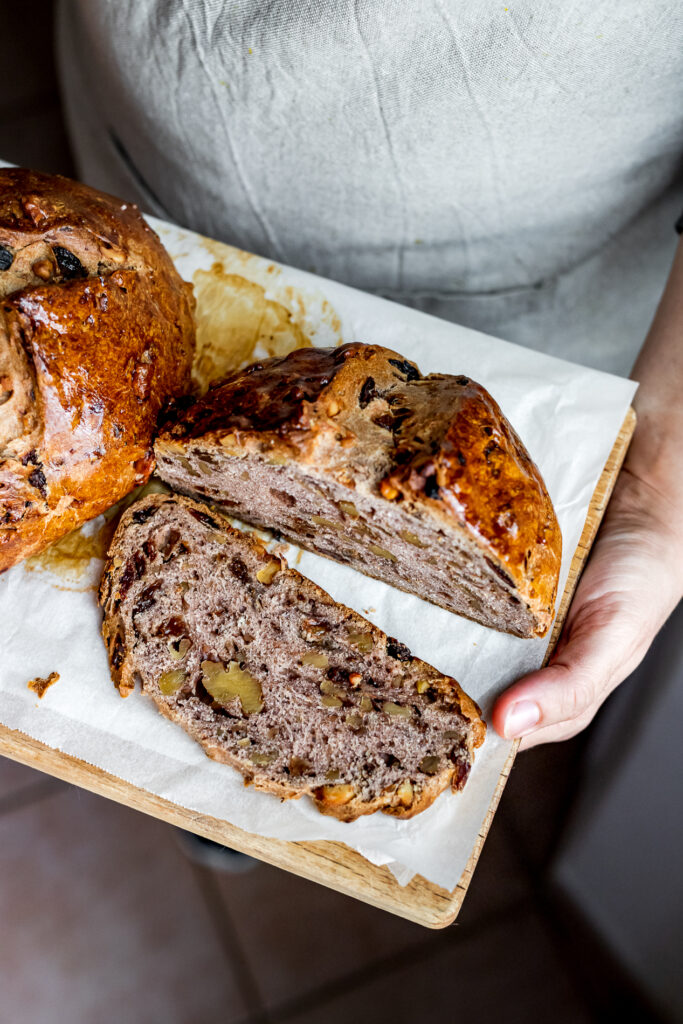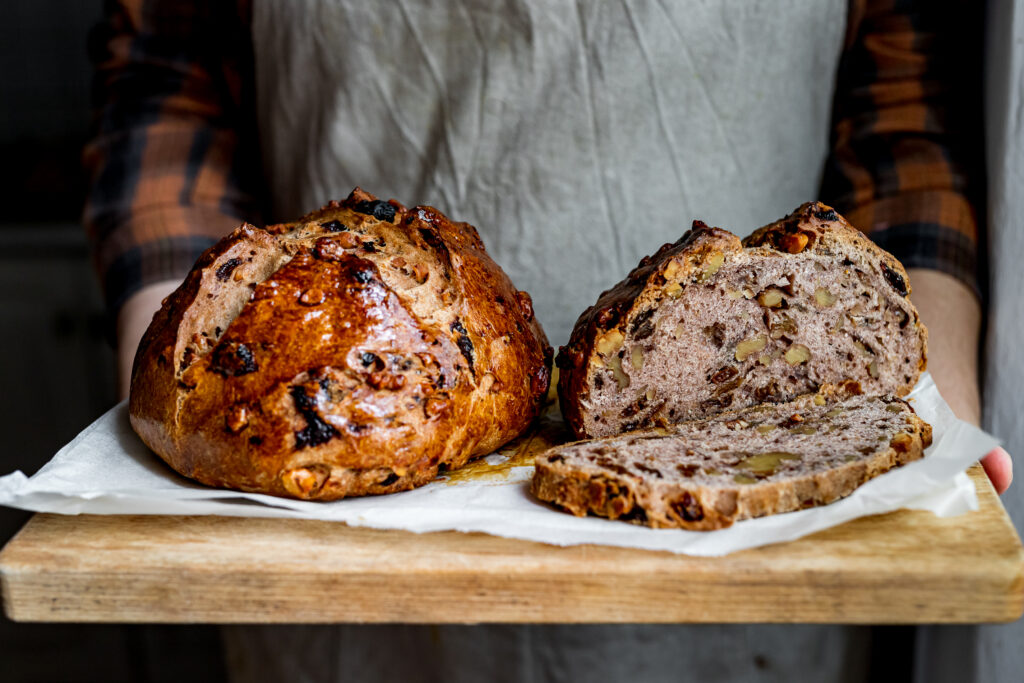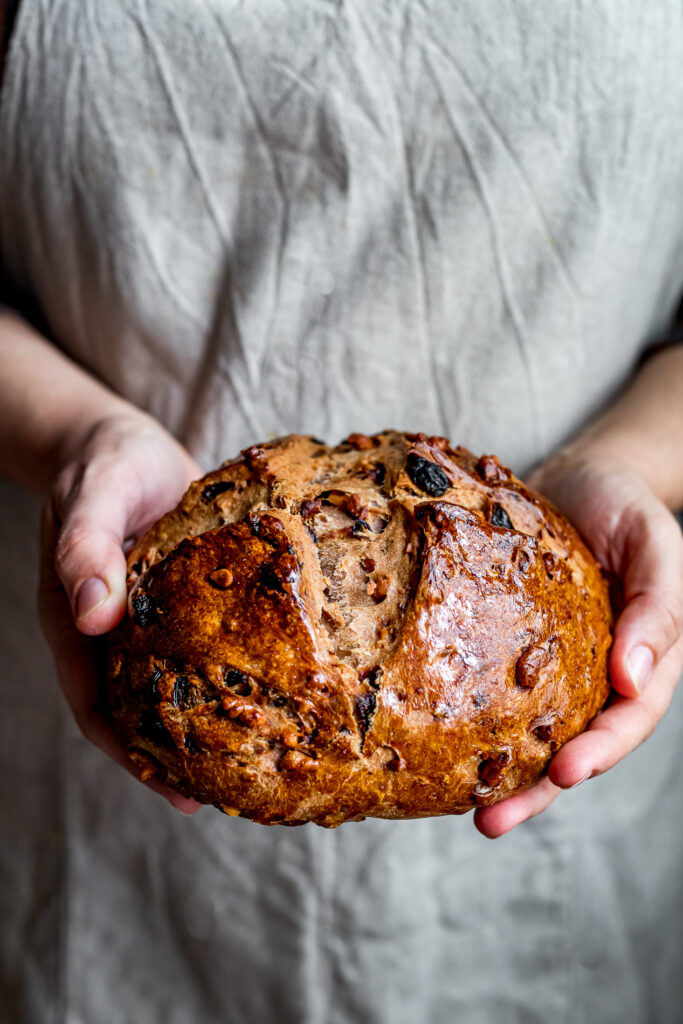Pan co’ Santi, a Tuscan walnut and raisin bread for All Saints’ Day
In Siena, you can always tell the time of year based on the types of sweets available at any given moment.
In September, a few spoonfuls of sugar and grapes are added to plain bread dough to make a schiacciata traditionally associated with the harvest. Late October to mid-November, on the other hand, means the arrival of pan co’ Santi.

Pan co’ Santi is a dense, spiced Tuscan bread, studded with raisins and walnuts, enriched with red wine, extra virgin olive oil, and sugar. In the past, they would use lard rather than olive oil, and a good spoonful of honey instead of sugar. It belongs to those enriched bread loaves that would be seasonally baked with what was available in the pantry at a given moment of the year: grapes in September to celebrate the harvest, aniseeds and eggs for Easter, raisins, walnuts, and red wine, to celebrate All Saints Day.
What looks like a rather heavy and dense bread loaf is indeed what ushers in the Tuscan festive season.
Its rustic crust glazed with egg yolk before baking glistens from every bakery counter until it will leave room for Christmastime treats like cavallucci, panforte and ricciarelli.

Pan co’ Santi, the Tuscan walnut and raisin bread
This recipe, shared in our cookbook From the Markets of Tuscany, is the result of years of experiments, and it is adapted from the recipes I was given by Gelsomino, my mum’s cousin and a former professional chef, and by my Aunt Teresa, the best cook in my Southern family branch.
I learnt to appreciate pan co’ Santi growing up. Now I am equally fascinated by its spiced, nutty taste and the rituality of baking it to welcome a more reflective, intimate season and to start the festivities. We enjoy pan co’ Santi to end the family meal of November the 1st, then I wrap it in a paper bag for my breakfast. I cut a thick slice of pan co’ Santi in the morning and toast it on a griddle pan until the nuts start to release their oil, and the raisins caramelize. Then I slather it with butter and a tart jam, my favourite being my mum’s plum jam. This is when I can really taste the festivities approaching.
Its spiced rich flavour makes it also a perfect bread to serve alongside a Sunday roast or topped with chicken liver pâté.

Bake pan co’ Santi and forget it for a couple of days on your kitchen counter, wrapped in a paper bag. It will mature and develop an intense, spiced flavour, and it will marry beautifully a tiny glass of vinsanto, our local sweet wine, or some fresh, new wine.
Pan co' Santi - Tuscan walnut and raisin bread
Ingredients
For the poolish (pre-ferment)
- 200 g bread flour
- 200 g water
- ¼ teaspoon active dry yeast
- 1 teaspoon sugar
For the dough
- 250 g raisins
- 100 g extra virgin olive oil
- 300 g shelled walnuts, roughly chopped
- 50 g sugar
- 50 g lukewarm water, + 1 teaspoon
- ½ teaspoon active dry yeast
- 600 g all-purpose flour
- 150 ml red wine
- 1 teaspoon fine sea salt
- ½ teaspoon freshly ground black pepper
- 1 egg yolk for glazing
Instructions
The night before you plan to bake the focaccia, make the poolish.
- In a large bowl stir together half of the water, the sugar, and the yeast and let it stand until creamy and froth, about 10 minutes. Stir in the flour and the rest of the water and mix with a whisk until roughly combined. Cover with a damp towel and let rise at room temperature overnight or for 8 to 12 hours.
Now make pan co' santi.
- In the morning, the poolish should be doubled in size, bubbly and lacy.
- For the dough, start by soaking the raisins in a bowl of water.
- Heat the olive oil in a pan, then add the drained raisins, the walnuts, and the sugar. Let the olive oil take on flavour, then remove from the heat and let cool.
- In a small bowl, stir together the water, 1 teaspoon of sugar, and the yeast and let it stand until creamy and froth, about 10 minutes.
- In a large bowl of a stand mixer, add the poolish, the flour, and the activated yeast, along with the nuts and raisins.
- Knead on low speed, adding the wine a little at a time, until the dough is well combined. It should be smooth to the touch and come away easily from your hands. Lastly, add the salt and pepper and knead for another minute.
- Turn the dough out onto an oiled pastry board. Form a round ball of dough, cover with a damp towel, and let rise for about 2 hours, until doubled in size.
- When the dough has doubled in size, knead it again, then divide and form 2 round bread loaves.
- Arrange the loaves, well-spaced, on a baking sheet lined with parchment paper. Cross the tops of each with a knife and let rise again until doubled in size, covered with a damp towel.
- Preheat oven to 175°C/350°F.
- Brush the bread loaves with a beaten egg yolk, transfer to the oven, and bake for about 50 minutes until dark brown and glossy. Remove the bread from the oven and let it cool thoroughly. Wait at least one day before consuming. Store wrapped in a tea towel or a paper bag.

An Update
Today I’m sharing a post I’ve written in 2009. I updated the old recipe inspired by a new approach to baking – far less yeast and a longer raising -, I added bits of history and tradition, and Tommaso shot new photos of the pan co’ Santi I baked yesterday. The faint smell of nuts, black pepper, wine and raisins was still lingering in the air while we took these photos in the afternoon light coming from the kitchen window.
It is a completely renewed post. I’m not disowning my own recipes and my beginnings. I’m very proud of where I came from, of the path Tommaso and I have chosen to walk together, of everything we’ve learnt along the way. But I’m not the woman I was 11 years ago.
At that time, I was rediscovering my family recipes, I was attempting my first steps in the kitchen, experimenting with baking heavy, hard-as-stone bread. Now this is my bread and butter. I made those traditions mine, I grew fond of time-honoured flavours, appreciating how modern, fresh, surprising they could be. After more than 10 years, I am more confident in the kitchen, many recipes have become staples in our family, and deserve some more love, new photos, and a proper introduction.
We want to share with you recipes that work, that can become part of your culinary repertoire, to make you feel at home in a Tuscan countryside kitchen.
More recipes for All Saint’s Day
- Bones of the dead. In Volterra, for some research for a cookbook, I entered one of those pastry shops with glittering windows, where you know right away, even before you set foot inside, that the atmosphere is relaxed, the choice is wide, and the welcome friendly and smiling. At the entrance, there were piles of brittle ossi di morto, the typical biscuits of Volterra, made with egg whites, sugar, flour and roasted hazelnuts, subtlety scented with lemon zest. Typical of All Saints’ and All Souls’ days, they open the holiday season. Today they can be found all year round for the happiness of those who love to dunk them in a glass of vin santo.
- All Saints’ Day muffins. I did a quick dessert that is not part of our culinary tradition, muffins, but I have enriched them with walnuts, raisins, red wine, and black pepper as befits the Tuscan pan co’ Santi. With these muffins, you can appreciate an old-world taste that often takes too long to be kneaded, raised, and baked in a very short time.
- In Lombardy, you can find a dark, dense bread similar to pan co’ Santi known as pan dei morti.
- My friend Rossella on her blog, shares the recipe for fave dei morti, from Le Marche.
- In Liguria, you can find pan dei santi e dei morti, like the one baked by my friend Enrica from A Small Kitchen in Genoa.

 Ciao! Questo contenuto è disponibile anche in Italiano.
Ciao! Questo contenuto è disponibile anche in Italiano. 




Mmm…. Such a delicious bake! I would love to have this with my coffee. Thank you.
Hello Giulia,
I simply LOVE pan di santo, I have been known to travel long distances and suffer parking fines to get my hands on a good pan di santo. . . . finally a recipe! so hopefully I can re-create that heavenly taste and texture!! Now I can have a go at home, a heartfelt thank you for a truly great recipe.
What does Zia Teresa do for her Christmas party? 🙂
ahah so many things! but not fish!
Just printed this recipe… it sounds so delicious!! Thank you!
thank you, Karen! I’d be so happy if you bake this Tuscan bread in your kitchen!
Excited to make this today, Grazie. Che bontà ! Pane Co’santi mi manca!
you will love it Julia, so happy you’ll be making it!
Just made this and it is absolute heaven!!!
yay! so happy to spread the pan co’ santi love!
Can you tell me about how long the last proof should be (step9)? Thanks
Hi Kitty, it really depends on the temperature of your kitchen, but I would say about2/3 hours
Thanks for your quick response. Can you over-proof the poolish? I am trying to figure out timing. If I proofed it for over 12 hours will it impact the dough? Thanks
12 hours would definitely work! No risk to over-proofing it!
Hi. I want to ask a few questions for clarity. I followed the recipe to the letter. When I added the Poolish, fand flour to the SM it was so very, very dry. So before adding in the fruit and nuts I slowly added the wine. Still way to dry. I bake bread a lot and never have seen one so dry that I dared not add the F&N mix into it. I added another 1/4+/-c water and it finally started to mix up okay, but not great. I pressed on and added the F&N mix in and the dough did not want to include them well so I put it all on my bread board and kneaded them in by hand. The dough I have to say does not feel correct. It is sitting under a damp cloth and covered snuggly for its 1st 2 hour proofing. I pray it comes together. Otherwise, that would be a lot of good money spent for no reward. I buy and used organic, so understand why I say that. Any suggestions of thoughts would be appreciated at this juncture. Thank you Juls.
I wish you had posted my questions as they were a cry for help. But I did say I would wait it out to the end. The bread turned out wonderful and looks exactly like yours in the picture. It did need a few tweaks but it turned out beautifully. I will be making it often, with the few tweaks as to hydration, otherwise bravo.
Hello Karen, I just read your two comments, I’m sorry. I’m happy eventually it turned out as in the photo! I will be making it again in a couple of days, so I’ll make sure to check if there’s something more to adjust!
Thank you for commenting. It did turn out exactly as your picture showed.
Is 1/8 tsp of yeast correct for the poolish? Maybe my yeast is old but I couldn’t get it to proof even with warm water. Missed All Saints Day.
Hello Roger, I am sorry. Mine worked with 1/8 of a teaspoon, but if the meat as old you might have needed more, maybe 1/4 of a teaspoon.
I’ll try the recipe again soon!
Thanks for the reply. After a couple of failed tries to get 1/8 tsp to proof I used 1 tsp in both the poolish and the dough and it turned out beautifully. I do suggest adding the salt and pepper with the flour since at the end the dough is so stiff it really doesn’t mix in well. Had a slice with breakfast and it was wonderful!
so happy to hear this!
Hi, can you please add kneading times to the recipe?
Hello Paula, it took me about 20 minutes to knead it with a stand mixer